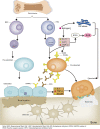Advances in Our Understanding of the Mechanism of Action of Drugs (including Traditional Chinese Medicines) for the Intervention and Treatment of Osteoporosis
- PMID: 35774616
- PMCID: PMC9237325
- DOI: 10.3389/fphar.2022.938447
Advances in Our Understanding of the Mechanism of Action of Drugs (including Traditional Chinese Medicines) for the Intervention and Treatment of Osteoporosis
Abstract
Osteoporosis (OP) is known as a silent disease in which the loss of bone mass and bone density does not cause obvious symptoms, resulting in insufficient treatment and preventive measures. The losses of bone mass and bone density become more severe over time and an only small percentage of patients are diagnosed when OP-related fractures occur. The high disability and mortality rates of OP-related fractures cause great psychological and physical damage and impose a heavy economic burden on individuals and society. Therefore, early intervention and treatment must be emphasized to achieve the overall goal of reducing the fracture risk. Anti-OP drugs are currently divided into three classes: antiresorptive agents, anabolic agents, and drugs with other mechanisms. In this review, research progress related to common anti-OP drugs in these three classes as well as targeted therapies is summarized to help researchers and clinicians understand their mechanisms of action and to promote pharmacological research and novel drug development.
Keywords: antiresorptive agent; bone; fracture; osteoblast; osteoclast; osteoporosis; pharmacological mechanism.
Copyright © 2022 Lu, Hu, Ma and Shuai.
Conflict of interest statement
The authors declare that the research was conducted in the absence of any commercial or financial relationships that could be construed as a potential conflict of interest.
Figures




Similar articles
-
Recent Progresses in the Treatment of Osteoporosis.Front Pharmacol. 2021 Jul 22;12:717065. doi: 10.3389/fphar.2021.717065. eCollection 2021. Front Pharmacol. 2021. PMID: 34366868 Free PMC article. Review.
-
Review on the protective activity of osthole against the pathogenesis of osteoporosis.Front Pharmacol. 2023 Aug 23;14:1236893. doi: 10.3389/fphar.2023.1236893. eCollection 2023. Front Pharmacol. 2023. PMID: 37680712 Free PMC article. Review.
-
Utilization of DXA Bone Mineral Densitometry in Ontario: An Evidence-Based Analysis.Ont Health Technol Assess Ser. 2006;6(20):1-180. Epub 2006 Nov 1. Ont Health Technol Assess Ser. 2006. PMID: 23074491 Free PMC article.
-
Evidence-based guidelines for the prevention and treatment of glucocorticoid-induced osteoporosis: a consensus document of the Belgian Bone Club.Osteoporos Int. 2006 Jan;17(1):8-19. doi: 10.1007/s00198-005-2032-z. Epub 2005 Oct 11. Osteoporos Int. 2006. PMID: 16217586
-
Appropriate models for novel osteoporosis drug discovery and future perspectives.Expert Opin Drug Discov. 2015;10(11):1201-16. doi: 10.1517/17460441.2015.1080685. Epub 2015 Aug 19. Expert Opin Drug Discov. 2015. PMID: 26292627 Review.
Cited by
-
Current comprehensive understanding of denosumab (the RANKL neutralizing antibody) in the treatment of bone metastasis of malignant tumors, including pharmacological mechanism and clinical trials.Front Oncol. 2023 Feb 13;13:1133828. doi: 10.3389/fonc.2023.1133828. eCollection 2023. Front Oncol. 2023. PMID: 36860316 Free PMC article. Review.
-
Modified Curcuminoid-Rich Extract Liposomal CRE-SDInhibits Osteoclastogenesis via the Canonical NF-κB Signaling Pathway.Pharmaceutics. 2023 Aug 30;15(9):2248. doi: 10.3390/pharmaceutics15092248. Pharmaceutics. 2023. PMID: 37765217 Free PMC article.
-
The analysis of Modified Qing' E Formula on the differential expression of exosomal miRNAs in the femoral head bone tissue of mice with steroid-induced ischemic necrosis of femoral head.Front Endocrinol (Lausanne). 2022 Aug 10;13:954778. doi: 10.3389/fendo.2022.954778. eCollection 2022. Front Endocrinol (Lausanne). 2022. PMID: 36034465 Free PMC article.
-
Molecular mechanisms and treatment strategies for estrogen deficiency-related and glucocorticoid-induced osteoporosis: a comprehensive review.Inflammopharmacology. 2025 May;33(5):2409-2445. doi: 10.1007/s10787-025-01749-3. Epub 2025 Apr 28. Inflammopharmacology. 2025. PMID: 40293652 Review.
-
Antioxidant 1,2,3,4,6-Penta-O-galloyl-β-D-glucose Alleviating Apoptosis and Promoting Bone Formation Is Associated with Estrogen Receptors.Molecules. 2024 Oct 29;29(21):5110. doi: 10.3390/molecules29215110. Molecules. 2024. PMID: 39519751 Free PMC article.
References
-
- Anderson G. L., Limacher M., Assaf A. R., Bassford T., Beresford S. A., Black H., et al. (2004). Effects of Conjugated Equine Estrogen in Postmenopausal Women with Hysterectomy: the Women's Health Initiative Randomized Controlled Trial. Jama 291 (14), 1701–1712. 10.1001/jama.291.14.1701 - DOI - PubMed
Publication types
LinkOut - more resources
Full Text Sources
Miscellaneous

